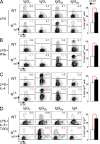Ikaros controls isotype selection during immunoglobulin class switch recombination
- PMID: 19414557
- PMCID: PMC2715033
- DOI: 10.1084/jem.20082311
Ikaros controls isotype selection during immunoglobulin class switch recombination
Abstract
Class switch recombination (CSR) allows the humoral immune response to exploit different effector pathways through specific secondary antibody isotypes. However, the molecular mechanisms and factors that control immunoglobulin (Ig) isotype choice for CSR are unclear. We report that deficiency for the Ikaros transcription factor results in increased and ectopic CSR to IgG(2b) and IgG(2a), and reduced CSR to all other isotypes, regardless of stimulation. Ikaros suppresses active chromatin marks, transcription, and activation-induced cytidine deaminase (AID) accessibility at the gamma2b and gamma2a genes to inhibit class switching to these isotypes. Further, Ikaros directly regulates isotype gene transcription as it directly binds the Igh 3' enhancer and interacts with isotype gene promoters. Finally, Ikaros-mediated repression of gamma2b and gamma2a transcription promotes switching to other isotype genes by allowing them to compete for AID-mediated recombination at the single-cell level. Thus, our results reveal transcriptional competition between constant region genes in individual cells to be a critical and general mechanism for isotype specification during CSR. We show that Ikaros is a master regulator of this competition.
Figures









References
-
- Muramatsu M., Kinoshita K., Fagarasan S., Yamada S., Shinkai Y., Honjo T. 2000. Class switch recombination and hypermutation require activation-induced cytidine deaminase (AID), a potential RNA editing enzyme.Cell. 102:553–563 - PubMed
-
- Revy P., Muto T., Levy Y., Geissmann F., Plebani A., Sanal O., Catalan N., Forveille M., Dufourcq-Labelouse R., Gennery A., et al. 2000. Activation-induced cytidine deaminase (AID) deficiency causes the autosomal recessive form of the Hyper-IgM syndrome (HIGM2).Cell. 102:565–575 - PubMed
-
- Petersen-Mahrt S.K., Harris R.S., Neuberger M.S. 2002. AID mutates E. coli suggesting a DNA deamination mechanism for antibody diversification.Nature. 418:99–103 - PubMed
Publication types
MeSH terms
Substances
LinkOut - more resources
Full Text Sources
Molecular Biology Databases
Miscellaneous

